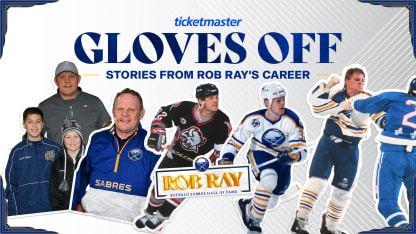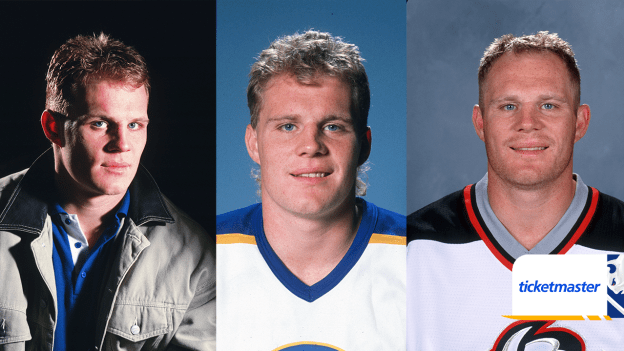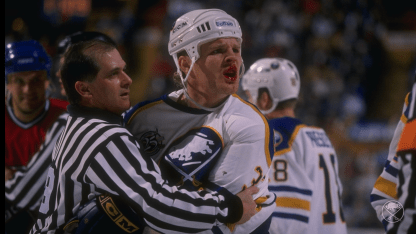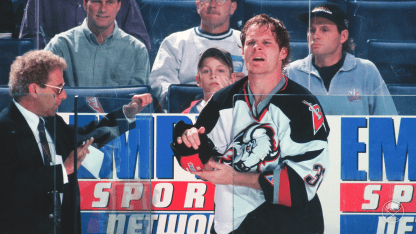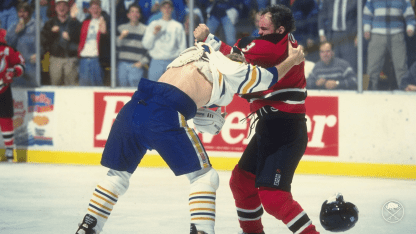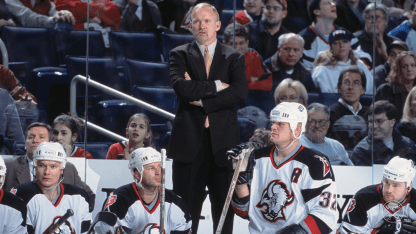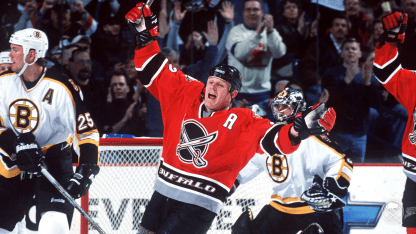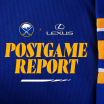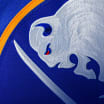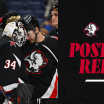Audette: I remember the next day, I think we’re playing in Toronto, and I couldn’t talk all the way there, I was so hurt in my mouth.
Hannan: When you get to know him over time, he backed everybody up. His teammates were a big part of his role. Back then, he would make sure he defended anybody – our stars, Pat LaFontaine, stuff like that.
Audette: When Rayzor was there, he policed the league. Guys like us, yeah we got hit and stuff. But when they were overboard, the team stuck together.
Ray: There was no better compliment than a teammate coming up and saying, “Hey, thank you. Thanks for bailing me out of that situation,” or, “Thanks for getting them off my back.”
Woolley: I always respected so much what he did for our team and for our teammates. I’ve always had a soft spot for the guys that stood up for me. I just love the guy.
Audette: For sure, with him in the lineup, I felt a lot bigger and a lot stronger.
Ray: If you walk away from the game and 99 percent of the people you played with could say, “He did his job, he was a good teammate,” that’s a win.
Audette: The thing with Rayzor, he makes you accountable for your game. Even if you’re one of the best players on the team and there’s nights you’re not going, he’s gonna get you going.
Sutton: You know how he was on the ice – he was rambunctious. Always go, go, go, like a turbo. And he was kind of like that off the ice.
Donnelly: It was at Montreal, the old Forum. I was already in the box, and he had done something really stupid on the ice. I don’t know, took a bad penalty. I can’t remember what it was. He started yakking and yakking and yakking, and he sits down beside me and he says, “I’m f –-d.” John Muckler was gonna give him s–-t.
We had a laugh attack in the penalty box in front of 18,000 people.
John Muckler coached the Sabres from 1991 to 1995 and served as general manager from 1993 to 1997.
Ray: Gordie and I had so much fun together. When he came here, for me it was like, “Okay, I don’t have to take all the big guys on, now you can do it.” After a while, Gordie was like, “I’m too old for this. Now you take the big guys.”
The two spent plenty of time together in the box. In 1991-92, Donnelly’s first season with the Sabres, he and Ray ranked sixth and second in the NHL, respectively, in penalty minutes.
Sutton: I made Buffalo, and we ended up living together for the whole time I was there, like five, five-and-a-half years. We drove to the rink together, pretty much did everything together. That’s when we became really good friends. We were kind of like Felix and Oscar. One was neat and one wasn’t. And guess what? I was the neat one.
Ray: Sutts always dressed perfect, acted perfect, clean place. Not so much on my side. We had apartments that were next door to each other, but we didn’t even shut our doors.
Audette: I got married in ’93. Rayzor, we weren’t friends and all that, but he came to my wedding. And I was like, “Wow, Rayzor came to my wedding.” He didn’t have to, but he came, and we ended up like at 3, 4-o-clock in the morning in the pool at the hotel, and my buddy Gino Odjick was there – I don’t think they ever fought after.
Surely Rayzor didn’t get into any fights at the wedding…
No…
Well, no. He scared a lot of people though.
Woolley: He’s very sarcastic. He’ll go right at you, but when he goes right at you, it means he likes you and he respects you.
Sutton: We played against each other in Buffalo. I think I was playing for New Jersey. We line up against each other – you know, we’re best friends – and he goes, “Let’s go, let’s fight.” And I’m like, “What? Are you crazy?” And he goes, “No, seriously, let’s fight. I won’t hurt you.” I’m like, “I’m not fighting you. Are you kidding me?”
Even if he wasn’t trying, he’d still kill me.
After their four-and-a-half seasons as teammates, Ray and Sutton played eight games head-to-head from 1995 to 2001.
Ray: I would never fight him. He was the kind of guy you could just say something to get him off his game.

